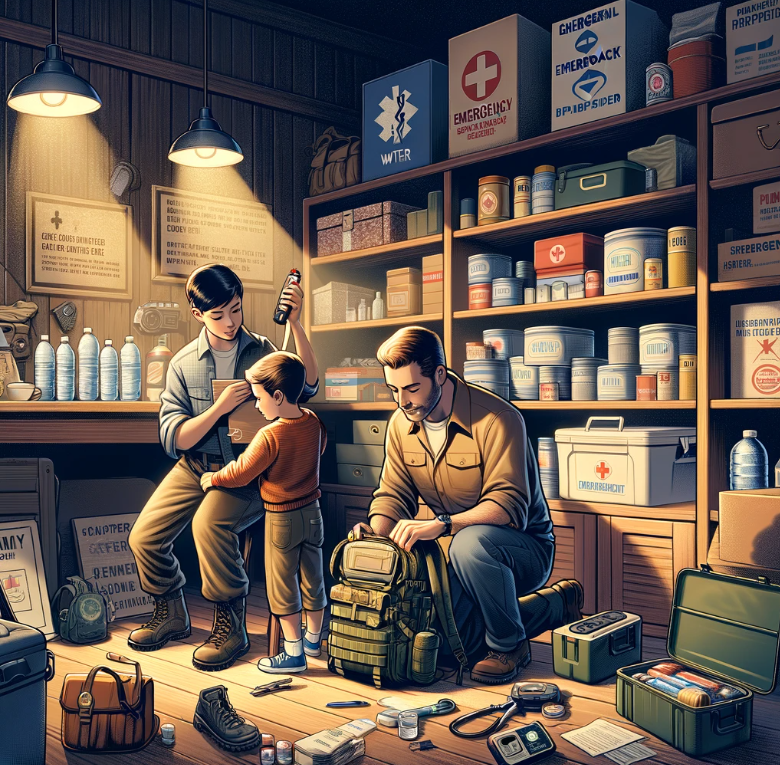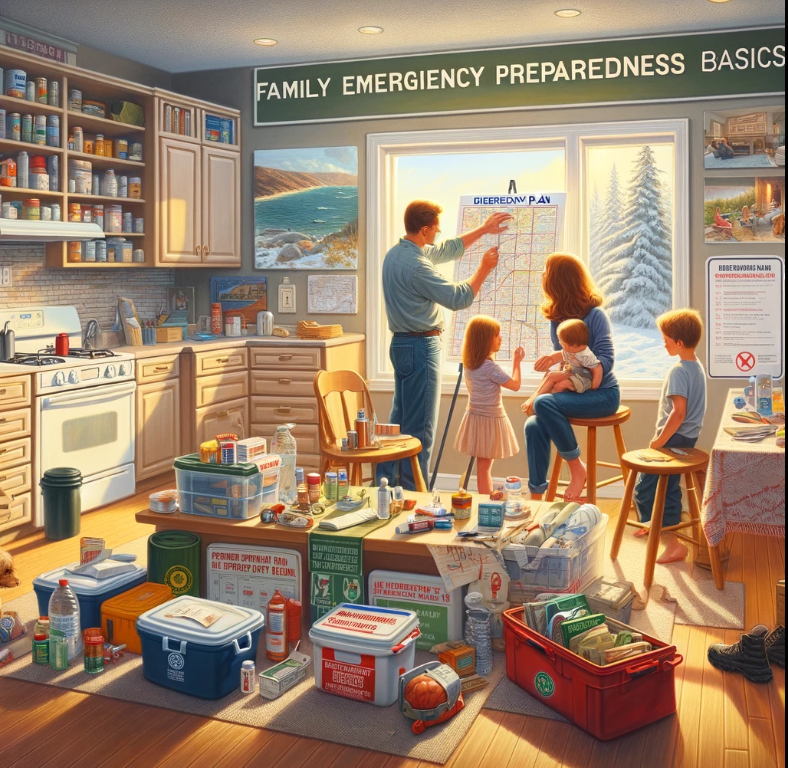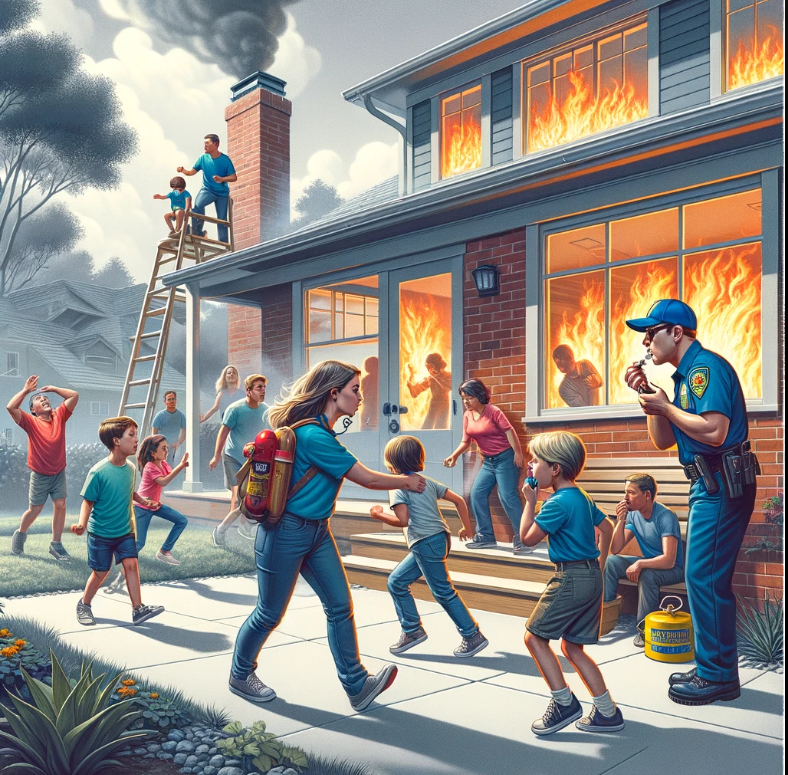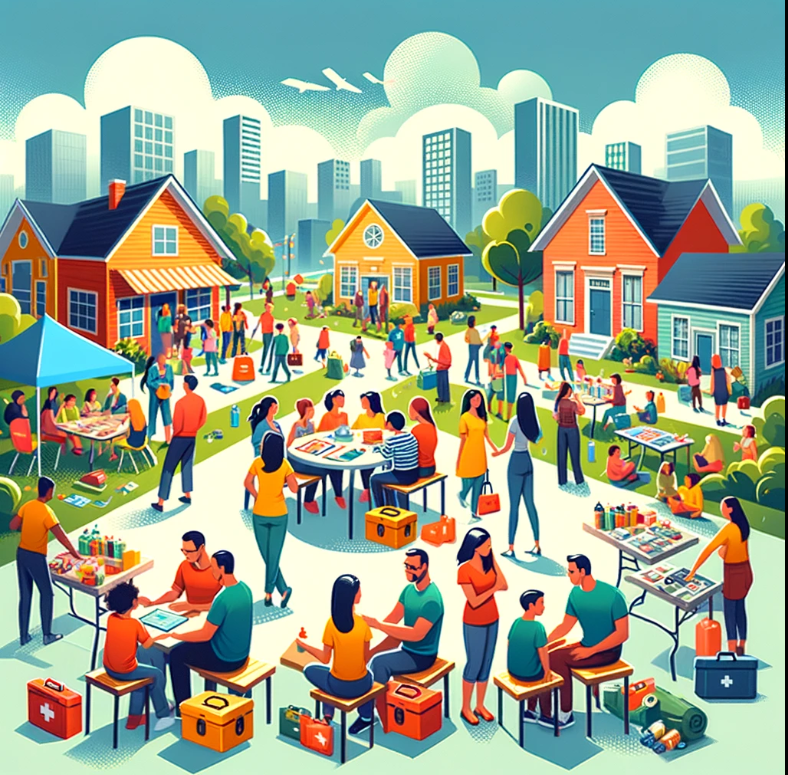Table of Contents
- 1 Introduction to Kids and Family Prepping
- 2 Understanding the Basics of Family Emergency Preparedness
- 3 Essential Gear and Supplies for Family Preparedness
- 4 Developing Survival Skills in Children
- 5 Creating a Family Emergency Plan
- 6 Practical Drills and Exercises for the Whole Family
- 7 Leveraging Technology for Safety
- 8 Building a Support Network
- 9 Mental Health and Coping Strategies
- 10 Closing Thoughts on Kids and Family Prepping
- 11 Frequently Asked Questions
- 11.1 Is family emergency preparedness important for families with children?
- 11.2 What are some essential gear and supplies recommended for family preparedness?
- 11.3 How can parents develop survival skills in their children?
- 11.4 Why is creating a family emergency plan important?
- 11.5 How can families leverage technology for safety during emergencies?
- 11.6 What role does mental health play in family emergency preparedness?
Views: 0
Introduction to Kids and Family Prepping
Importance of Teaching Survival Skills to Children

Teaching kids survival skills is crucial as it prepares them for emergencies. By educating children on basic survival techniques, such as how to create a shelter or methods for sourcing, and long-term food storage in the wild, they can become more self-reliant during unexpected situations. This knowledge instills confidence in children, empowering them to stay calm and take appropriate actions when faced with adversity.
Encouraging children to learn about prepping also fosters a sense of responsibility and emergency preparedness within the family unit. When kids understand the importance of being ready for emergencies, they actively participate in creating and practicing emergency plans with their families. Involving children in these preparations not only educates them but also strengthens family bonds by working together towards a common goal of safety and readiness.
Benefits of Family Emergency Preparedness
Family emergency preparedness ensures everyone’s safety by establishing clear protocols and communication and navigation strategies during crises. Having a well-thought-out emergency plan that includes all family members helps minimize confusion and panic in high-stress situations. By regularly practicing drills and discussing different scenarios, families can enhance their response capabilities and improve overall post-disaster outcomes.
Moreover, involving children in the family’s emergency preparedness efforts empowers them to contribute meaningfully during times of crisis. Kids can assist in gathering essential supplies, contacting emergency services if needed, or even providing emotional support to other family members. This active involvement not only boosts children’s confidence but also reinforces the importance of teamwork and solidarity within the family unit.
Understanding the Basics of Family Emergency Preparedness
The necessity of having an emergency plan for families
An emergency plan is vital for families to navigate crises efficiently. It keeps everyone organized, reducing panic and confusion when emergencies strike. A well-prepared family has a higher chance of surviving and recovering quickly from disasters. For instance, in case of a flood, having an evacuation plan can ensure everyone’s safety.

A family emergency plan is crucial because it helps avoid chaos during unexpected events. When each family member knows their role, communication becomes smoother, making it easier to handle emergencies effectively. In situations like wildfires or earthquakes, having a clear plan can make all the difference between staying safe or facing unnecessary risks.
Key components of a family emergency plan
Communication forms the backbone of any effective emergency plan for families. Establishing how to communicate during emergencies ensures that everyone stays informed and connected when separated. Alongside communication strategies, identifying evacuation routes beforehand is essential for quick and safe exits during disasters like hurricanes or tornadoes. Determining specific meeting points where all family members gather post-evacuation enhances coordination efforts in times of crisis.
Essential Gear and Supplies for Family Preparedness
List of essential emergency supplies for families

Families should always have water storage solutions in place, ensuring there’s enough for each member. Stock up on food, including non-perishable items with a long shelf life. A first aid kit is crucial, containing basic medical supplies like bandages and antiseptic wipes.
Recommendations for kid-friendly survival gear
When prepping with kids in mind, consider lightweight and easy-to-use flashlights that are suitable for children. Providing whistles can help attract attention if needed during emergencies. Keep compact child-sized emergency blankets handy to provide warmth and comfort.
Developing Survival Skills in Children
Age-appropriate survival skills for children
Teaching kids basic first aid, such as applying bandages and treating minor injuries, is crucial. Educating them about fire safety and how to safely extinguish fires helps prevent accidents. For older children, navigation skills are essential; teaching them how to use a compass or read maps can be valuable.

- Pros:
- Equips children with life-saving knowledge
- Increases their self-confidence and independence
- Cons:
- Requires supervision initially to ensure proper understanding
Role-playing games can make learning survival skills enjoyable for children. By acting out various emergency scenarios, kids learn practical responses in a fun way. Using camping trips as opportunities to teach survival skills not only educates but also creates memorable experiences for the whole family.
Fun and engaging ways to teach survival skills to kids
Storytelling about real-life survival situations captivates children while imparting valuable lessons. Sharing stories of success can inspire kids and alleviate any fear they may have regarding emergencies. Involving them in cooking activities during outdoor adventures teaches them how to produce food independently.
- Teach basic first aid like applying bandages.
- Educate on fire safety measures.
- Engage older kids in learning navigation using maps or a compass.
Outdoor adventures provide hands-on experience that reinforces the importance of acquiring survival skills early on. Despite initial fears, success in mastering these abilities boosts children’s confidence levels significantly.
Creating a Family Emergency Plan
Step-by-step guide on how to create an effective family emergency plan

Creating a family emergency plan is crucial for ensuring the safety and well-being of your loved ones during unexpected events. Start by assessing risks in your area, such as natural disasters like tornadoes, earthquakes or hurricanes. Identify potential hazards that could affect your family and home. Once you understand the risks, you can better prepare for them.
Developing a communication plan is essential for keeping everyone connected during emergencies. Establish how family members will stay in touch if separated. Designate meeting points both inside and outside your neighborhood in case communication lines are down. Consider using multiple communication methods like text messages, phone calls, or social media to ensure everyone can be reached.
Next, assemble an emergency kit with essential supplies to sustain your family during crises. Include items like non-perishable food, water, medications, first aid supplies, flashlights, batteries, and important documents in your kit. Customize it based on the needs of each family member including infants or pets. Keep the emergency kit in an easily accessible location known to all family members.
Practical Drills and Exercises for the Whole Family
Planning and Executing Family Emergency Drills
Regularly practice emergency drills with your family to ensure everyone knows what to do in case of an emergency. Conduct fire drills to make sure all family members can exit safely in the event of a fire. It’s crucial to simulate various emergency scenarios to test your family’s readiness and identify areas that need improvement.

Teach your family how to construct temporary shelters outdoors as part of outdoor survival skill exercises. Learning about edible plants and teaching kids how to identify them can be valuable in a survival situation where food may be scarce. Set up navigation challenges like treasure hunts using compasses or GPS devices, which not only teach important skills but also make learning fun for kids.
Outdoor Survival Skill Exercises for Families
Practice building a shelter with your family, using materials found in nature or basic camping supplies. Foraging for food can be turned into a fun activity by going on nature walks and teaching children about safe-to-eat plants. Navigation challenges such as setting up treasure hunts help improve map reading skills and understanding directions, essential for survival situations.
Involving kids in practical drills like constructing shelters or identifying edible plants instills valuable life skills while fostering teamwork within the family unit. By practicing evacuation procedures regularly, families can ensure that everyone knows what steps to take during emergencies without panicking. Simulating different emergency scenarios helps families prepare for unexpected events effectively.
Leveraging Technology for Safety
Apps and Gadgets for Family Safety

Emergency alert apps are essential tools that provide real-time emergency notifications to keep families informed during crises. By installing these apps on smartphones, families can receive immediate alerts about natural disasters, amber alerts, or other emergencies in their area. For instance, the Red Cross Emergency App offers features like shelter locations and safety tips.
Wearable GPS trackers are valuable gadgets that enhance family safety by allowing parents to track the whereabouts of their children in real time. These devices come in various forms, such as smartwatches or small trackers attached to backpacks. They enable parents to monitor their kids’ locations and receive alerts if they stray from designated safe zones.
Weather monitoring apps play a crucial role in keeping families safe by providing up-to-date information on weather conditions. Families can stay informed about approaching storms, hurricanes, or extreme temperatures through these apps. For example, The Weather Channel app offers detailed forecasts and severe weather alerts to help families prepare for adverse conditions.
Teaching Kids About Cryptocurrency
Introducing children to cryptocurrency educates them about an alternative form of money that operates independently of traditional banking systems. By explaining cryptocurrency as a decentralized currency, kids learn how it differs from government-issued money like dollars or euros. This knowledge prepares them for potential scenarios where conventional financial systems may fail.
Discussing the benefits and risks associated with alternative money systems helps children understand the complexities of financial independence and diversification. Kids learn that while cryptocurrencies offer increased privacy and security compared to fiat currencies, they also pose risks such as volatility and regulatory uncertainties. Encouraging children to explore different monetary options fosters a mindset of adaptability and preparedness for future economic landscapes.
Building a Support Network
Importance of community support and how to engage with local emergency preparedness groups
Engaging with local emergency preparedness groups is crucial for families. Joining these groups allows families to benefit from the experience of seasoned individuals in emergency situations. By participating in community drills and exercises, kids can learn valuable skills that are essential for their safety during emergencies.

Sharing resources and knowledge with neighbors not only strengthens the bond within the community but also ensures that everyone is better prepared for unexpected events. Through collaboration, families can create a robust support network that enhances their overall level of readiness.
- Join local emergency preparedness groups
- Participate in community drills and exercises
- Share resources and knowledge with neighbors
Building connections within the neighborhood can provide a sense of security knowing that there are people around who can offer help during challenging times. By actively engaging with local emergency preparedness initiatives, families can cultivate a supportive environment where everyone works together towards a common goal of ensuring safety and well-being.
Collaborating with others also opens up opportunities to access additional resources, information, and expertise that may be beneficial in times of crisis. This collective effort fosters a sense of unity among families, making them more resilient in facing various emergencies.
Mental Health and Coping Strategies
Addressing the Psychological Impact of Emergencies on Children

During emergencies, kids and family prepping can be stressful for children. Providing emotional support is crucial. Encourage open communication to help children express their feelings freely. If signs of prolonged distress or trauma persist, seek professional help promptly.
Children may experience various challenges during emergencies, affecting their mental well-being. Ensuring emotional support is essential in helping them cope effectively. By offering reassurance and a safe space for expression, parents can significantly impact their children’s ability to navigate through difficult situations.
Coping Mechanisms and Resources for Families
When facing unexpected situations, families can employ coping mechanisms to manage stress levels effectively. Regular exercise plays a vital role in reducing anxiety and promoting overall well-being. Relaxation techniques like deep breathing exercises or meditation can help alleviate tension and promote mental clarity.
Engaging with support networks is another valuable resource for families during challenging times. Connecting with others who share similar experiences can provide comfort and understanding. Counseling services are also available to offer professional guidance when needed, ensuring families have access to comprehensive support systems.
Closing Thoughts on Kids and Family Prepping

In the realm of kids and family prepping, prioritizing safety and readiness is paramount. Equipping children with essential survival skills, devising comprehensive emergency plans, and fostering a supportive network are all crucial elements in preparing for unforeseen circumstances. By incorporating practical drills, leveraging technology for enhanced safety measures, and addressing mental health aspects, families can fortify their resilience in times of crisis. Physical fitness is also a good topic to educate kids on, as being in shape during a crisis can be the difference between surviving and dying.
With a proactive approach to family preparedness, individuals can navigate emergencies with confidence and efficiency. By implementing the strategies outlined in this guide, families can significantly enhance their ability to handle various scenarios effectively. It is imperative to remember that preparedness is an ongoing process that requires diligence and adaptability. Stay informed, stay vigilant, and prioritize the safety and well-being of your loved ones above all else.
Frequently Asked Questions
Is family emergency preparedness important for families with children?
Family emergency preparedness is crucial for families with children to ensure their safety and well-being during unexpected events. Teaching kids about preparedness builds resilience and reduces fear in emergencies. Keeping emergency preparedness kits and educating kids on how to use their contents in crisis situations is also a good idea.
What are some essential gear and supplies recommended for family preparedness?
Essential gear includes first aid kits, non-perishable food, water, flashlights, batteries, blankets, and a multi-tool. Having these items readily available can help families handle various emergency situations effectively.
How can parents develop survival skills in their children?
Parents can teach survival skills to children through activities like camping trips, nature hikes, basic first aid training, fire safety lessons, and teaching them how to use tools safely. These experiences help children become more self-reliant in emergencies.
Why is creating a family emergency plan important?
Creating a family emergency plan ensures that every member knows what to do during different emergencies. It helps coordinate actions, communication methods, meeting points, and responsibilities beforehand for a more organized response.
How can families leverage technology for safety during emergencies?
Families can use technology like emergency alert apps, GPS tracking devices for kids or pets, two-way radios or walkie-talkies for communication when networks are down. Technology enhances communication and provides real-time information during crises.
What role does mental health play in family emergency preparedness?
Mental health is crucial as it affects decision-making under stress. Teaching coping strategies like deep breathing exercises or mindfulness techniques helps reduce anxiety levels during emergencies and promotes clearer thinking among all family members.





Pingback: 10 Essential Steps to Starting a Thriving Prepper Community